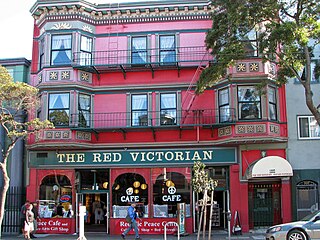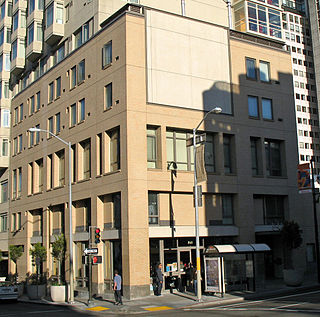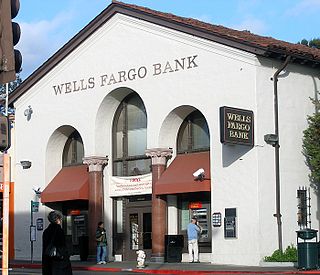
St. Francis Wood is a residential neighborhood located in southwestern San Francisco, California, south of the West Portal neighborhood and west of Mount Davidson. St. Francis Wood had a population of 1,229 and a median household income of $179,244 in 2019. Characterized by family homes on spacious lots, St. Francis Wood has no visible businesses and has a correspondingly low profile compared to similar wealthy neighborhoods such as the Marina District and Pacific Heights. St. Francis Wood is one of eight master-planned residence parks in San Francisco.

The San Francisco Theatre District is a neighborhood in San Francisco named for the legitimate theaters located there. The district encompasses part of the Union Square shopping district and the Tenderloin and Civic Center neighborhoods. Theaters in the area include the Orpheum Theatre, Curran Theatre, Golden Gate Theatre, San Francisco Playhouse, and American Conservatory Theater.

The Red Victorian is a historic hotel on Haight Street in San Francisco's Haight-Ashbury district, two blocks from Golden Gate Park.

Single room occupancy is a form of housing that is typically aimed at residents with low or minimal incomes who rent small, furnished single rooms with a bed, chair, and sometimes a small desk. SRO units are rented out as permanent residence and/or primary residence to individuals, within a multi-tenant building where tenants share a kitchen, toilets or bathrooms. SRO units range from 7 to 13 square metres. In some instances, contemporary units may have a small refrigerator, microwave, or sink.

The International Hotel, often referred to locally as the I-Hotel, was a low-income single-room-occupancy residential hotel in San Francisco, California's Manilatown. It was home to many Asian Americans, specifically a large Filipino American population. Around 1954, the I-Hotel also famously housed in its basement Enrico Banduccci's original "hungry i" nightclub. During the late 60s, real estate corporations proposed plans to demolish the hotel, which would necessitate displacing all of the I-Hotel's elderly tenants.

The Claremont district is a neighborhood straddling the city limits of Oakland and Berkeley in the East Bay section of the San Francisco Bay Area in California, United States. The main thoroughfares are Claremont and Ashby Avenues.

Parkmerced is a neighborhood in San Francisco, California, designed by architects Leonard Schultze and Thomas Dolliver Church in the early 1940s. Parkmerced is the second-largest single-owner neighborhood of apartment blocks west of the Mississippi River after Park La Brea in Los Angeles. It was a planned neighborhood of high-rise apartment towers and low-rise garden apartments in southwestern San Francisco for middle-income tenants.

The Tenderloin is a neighborhood in downtown San Francisco, in the flatlands on the southern slope of Nob Hill, situated between the Union Square shopping district to the northeast and the Civic Center office district to the southwest. It encompasses about 50 square blocks, and is a large wedge/triangle in shape. It is historically bounded on the north by Geary Street, on the east by Mason Street, on the south by Market Street and on the west by Van Ness Avenue. The northern boundary with Lower Nob Hill has historically been set at Geary Street. The area has among the highest levels of homelessness and crime in the city.
CitiApartments was one of the largest real estate companies in San Francisco, California, which at its peak owned and managed more than 300 buildings directly and through a number of affiliates. In recent years the companies suffered a financial downturn, and have been the subject of intense criticism and litigation for allegedly illegal business practices as a residential landlord.

The Elmwood District is a neighborhood of the City of Berkeley, California. It is primarily residential, with a small commercial area. The district does not have set lines of demarcation, but is focused around College and Ashby Avenues. The most extreme definitions of the district's boundaries do not extend past Telegraph Avenue to the west, Dwight Way to the north, or the Oakland city limit to the south. Elmwood was a streetcar suburb that was developed in the 1900s housing boom following the 1906 San Francisco earthquake, and was the first Berkeley subdivision to be assigned single-family residential zoning.

Subsidized housing in the United States is administered by federal, state and local agencies to provide subsidized rental assistance for low-income households. Public housing is priced much below the market rate, allowing people to live in more convenient locations rather than move away from the city in search of lower rents. In most federally-funded rental assistance programs, the tenants' monthly rent is set at 30% of their household income. Now increasingly provided in a variety of settings and formats, originally public housing in the U.S. consisted primarily of one or more concentrated blocks of low-rise and/or high-rise apartment buildings. These complexes are operated by state and local housing authorities which are authorized and funded by the United States Department of Housing and Urban Development (HUD). In 2020, there were 1 million public housing units.
Henry "Hank" Wilson was a longtime San Francisco LGBT rights activist and long term AIDS activist and survivor. The Bay Area Reporter noted that "over more than 30 years, he played a pivotal role in San Francisco's LGBT history." He grew up in Sacramento, and graduated with a B.A. in education from the University of Wisconsin–Madison in 1971.
Randy Shaw is an attorney, author, and activist who lives in Berkeley, California. He is the executive director of the Tenderloin Housing Clinic, a nonprofit organization in San Francisco that he co-founded in 1980. He has also co-founded and is on the board of directors of Uptown Tenderloin, Inc., a nonprofit organization that spearheaded the creation of the national Uptown Tenderloin Historic District in 2009. Uptown Tenderloin, Inc. is also the driving force behind the Tenderloin Museum, which opened in the spring of 2015. Randy is also the editor of Beyond Chron, and has written six books on activism.
The Ellis Act is a 1985 California state law that allows landlords to evict residential tenants to "go out of the rental business" in spite of desires by local governments to compel them to continue providing rental housing.

Christopher Statton is an American artist and arts administrator, community activist, and philanthropist, and activist based in the San Francisco Bay Area. Statton is best known for his role in establishing San Francisco's oldest continuously running theater, the Roxie Theater as a non-profit during his four-year tenure as executive director, 2010 – 2013. In 2013 he was awarded the Marlon Riggs Award by the San Francisco Film Critics Circle for “his significant contribution to San Francisco’s film community through the Roxie Theater over the past four years.” Ryan Coogler also received the award for his film Fruitvale Station. In 2013, San Francisco District 9 Supervisor David Campos awarded Statton with a Certificate of Honor for his “important and tireless work with the Roxie.” Statton resigned from the Roxie in 2013 due to health concerns.

Aaron Dan Peskin is an American elected official in San Francisco, California. He serves as a member of the San Francisco Board of Supervisors representing District 3, and is currently Dean of the Board. He was elected in 2015, having previously served two terms in 2001–2009. Peskin is currently serving his fourth term as District Supervisor.

Nob Hill is a neighborhood of San Francisco, California that is known for its numerous luxury hotels and historic mansions. Nob Hill has historically served as a center of San Francisco's upper class. Nob Hill is among the highest-income neighborhoods in the United States, as well as one of the most desirable and expensive real estate markets in the country.

The gentrification of San Francisco has been an ongoing source of tension between renters and working people who live in the city as well as real estate interests. A result of this conflict has been an emerging antagonism between longtime working-class residents of the city and the influx of new tech workers. A major increase of gentrification in San Francisco has been attributed to the Dot-Com Boom in the 1990s, creating a strong demand for skilled tech workers from local startups and close by Silicon Valley businesses leading to rising standards of living. As a result, a large influx of new workers in the internet and technology sector began to contribute to the gentrification of historically poor immigrant neighborhoods such as the Mission District. During this time San Francisco began a transformation eventually culminating in it becoming the most expensive city to live in the United States.

Boeddeker Park, more formally known as Father Alfred E. Boeddeker Park, is an urban park in the Tenderloin neighborhood of San Francisco. This 1-acre park was renovated and reopened in 2014, especially intended to serve the needs of people in the surrounding neighborhood who experience amongst the highest levels of poverty in the city. The park was completed with a large mural, Everyone Deserves a Home, on the building above the park in 2016.
















